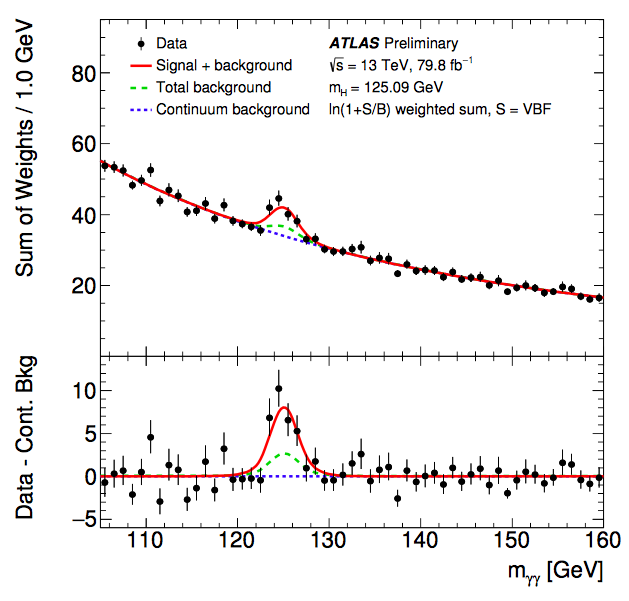ATLAS Experiment Observes VBF Higgs Production
The ATLAS experiment at the Large Hadron Collider (LHC) presented the latest results on Higgs physics at the International Conference of High Energy Physics in Seoul on July 9th. The results included the observation of the Higgs boson via Weak Boson Fusion (VBF) and other combined measurements of Higgs boson.
As the first observation of the VBF signal from a single experiment at the LHC, it is important for the studies of the Higgs boson production, the electroweak interaction, and new physics. The ATLAS group from the Institute of High Energy Physics (IHEP) made major contributions to this result, which is highlighted in the linked ATLAS ICHEP conference note.
There are four different processes that can produce a Higgs particle: gluon-gluon fusion (ggF), VBF, W/Z associated production (W/ZH), and top quark-antiquark pair associated production (ttH). Of these, ggF contributes 88% of the production, VBF counts for 7%, and the other two together around 5%. The ggF process was the major contributor to the Higgs discovery in 2012.
After the historical discovery of the Higgs boson, it is crucial to observe Higgs particles from different productions and decay modes, as well as to make measurements of the spin, parity, cross-sections, couplings etc. Those measurements can not only improve our understanding of the properties of the Higgs particle, but also help us explore new physics beyond the SM.
The released VBF measurement combines four decay channels:
ATLAS and CMS members from Peking University, Beihang University, IHEP, Nanjing University, Tsinghua University, Shandong University, Shanghai Jiao Tong University and the University of Science and Technology of China are very active in the study of Higgs-related physics.
The wider ATLAS IHEP group contributed to the ATLAS muon spectrometer construction and was taking leading roles in the Pixel detector data acquisition system and operations, and on the work required to identify photons, tau leptons and Higgs combination. These elements were key for the results reported here.
Prof. Fang Yaquan, Mr. Zhang Yu, the Ph.D. student and Prof. Lou Xinchou played a leading role in the analysis of VBF

Figure 1: Distribution of the mass of the di-photon for the VBF Higgs decaying into di-photons with 79.8 fb-1 ATLAS RUN2 data (Image by ATALS Collaboration)
Further reading:
ATLAS news: http://atlas.cern/updates/physics-briefing/combined-measurements-higgs-boson
Contact Information
Mr. Guo Lijun
ljguo@ihep.ac.cn